Work Design Magazine Publisher, Bob Fox, shares his thoughts on the on-going open office debate.
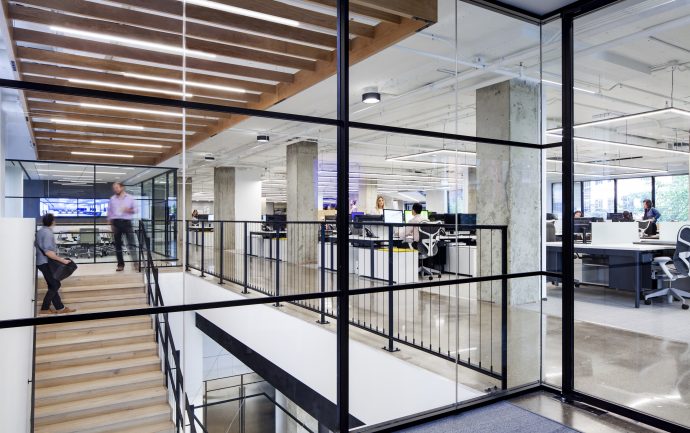
Recently, there has been much press about open office plans, mostly about how bad these work environments are and that they don’t work. As Principal of FOX Architects and Publisher of Work Design Magazine; an architect and workplace strategist reading one of these articles are kind of like someone saying, “my shoes don’t fit.” Office space can be analogous to shoes in that you may be wearing the wrong pair shoes. Moreover, like shoes, if you put the wrong pair or the wrong size on – there is no question you’re going to, at best be a little uncomfortable and at the worst, in pain, with the shoes not appropriate for your activities. You don’t go running in high-heels – office space is not much different – don’t do your work in the wrong space.
Let’s Do the Math
Office space is costly. In large urban markets, it’s not uncommon to be paying $50/SF per year. As a simple example, if you do the math, a company with 100 people will on average require about 20,000 SF of space. The rent, in that case, totals $1 million per year or $83,000 per month.
Switching to an open office plan, you can easily save 25 percent or in this case 5,000 SF. You just saved your company $250,000 per year, enough to hire about three people, including taxes and benefits; and that saving is each year, over the life of an office lease the dollars are significant.
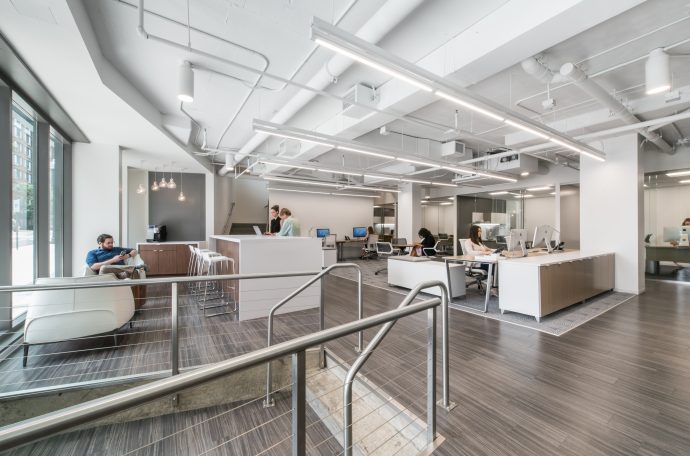
If you are a facility manager, it’s an easy decision to squeeze a little and move into an open office environment. That was the trend a few years ago, and what’s more, it was supposed to be good for collaboration.
The facility management profession measures cost, efficiency, and the effective operation of corporate office space. To reduce occupancy costs, they aggressively cut square footage, increased head counts, and supported remote work.
Am I Too Late?
Office space is changing – and it is often confusing for organizations coming out of older generation space. There is not a lot of research or credible information; and few instructions for organizations trying to adapt themselves to a more modern office. The longer you have been in your existing office, the harder it is to make the jump to a newer, up to date office – it is not an easy change to make. The entire organization needs to relearn and adapt.
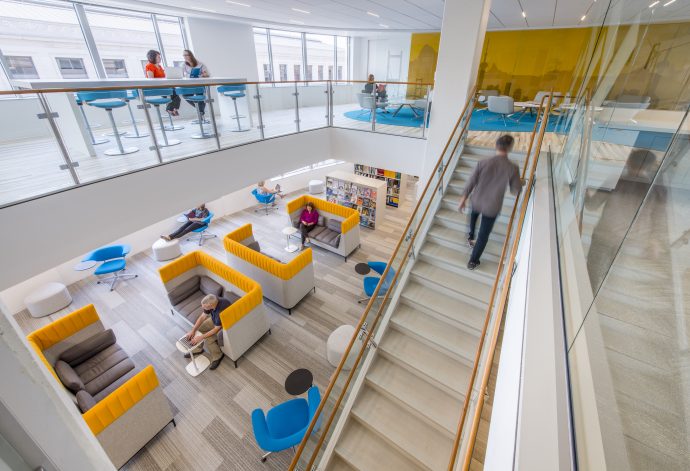
Today almost all the workspace that we are designing is a combination of spaces. In fact, it is not uncommon to have 15 -20 different types of places to work, a range of open and closed, public and private, individual and group, high and low tech, all in one office. When put together properly, each type of space increases flexibility and can support a variety of work, ranging from heads down places for focus and concentration, group spaces for collaboration, meetings, and communication. A single type of office or workstation cannot accommodate all the different tasks or functions that we must perform in a day. Thus, the root of the problem with an all open concept.
Seeing the Office as a Tool
As office rents rise, there is a shift in workplace planning with more focus on ways to increase the value that office space can bring to an organization. That is almost a complete 180-degree turn from the traditional approach to maximize the efficient operation and reduce the cost of the office environment.

If you are scratching your head trying to understand that concept, you are not alone. There has been a Cost vs. Value debate for years, the idea of value is often relative, intangible, subjective and is difficult to measure. The goal or strategy will be different for each company. An example that might make it a little easier to understand is the current emphasis on using space as a tool to attract talent.
A well thought out design is now one of the big drivers pushing the value side of the conversation. In my professional work with clients, there is nothing that dominates the conversation among leadership as much as the need to hire top talent. Success is dependent on the ability to bring in the “best and brightest” potential employees, and the office environment is one of the most significant factors that can influence the person’s desire to join, and current employees plans to stay. I often hear – “We need cool space to attract the best talent.” The term “cool” is subjective; it’s a value judgment. It’s not entirely clear on how you measure “cool”, but it represents a significant value for those occupying new office space.
What about Collaboration?
Collaboration is a challenging word, especially for architects and designers. It is a generic term that is overused, and not very well undefined. If you say “I need collaboration space” – an architect or designer must interpret what you mean. Issues like the type of work, work surface, lighting, technology & AV, whiteboards, acoustics, degree of openness, accessibility, privacy, flexibility, and other factors all must be considered and accounted for in the design solution.
Collaboration needs separation from other activities. The right tools and technology need to be in place to set the stage for the proper type of interaction. People just don’t collaborate if you put a few chairs in an open area. The spaces that we design are much more sophisticated and offer a greater variety of tools.
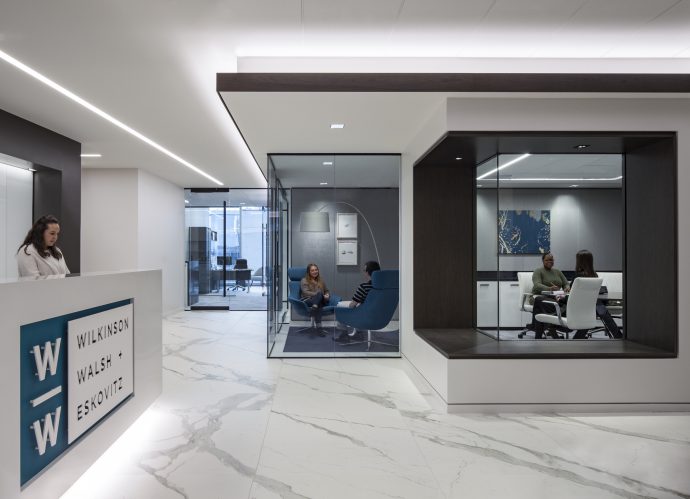
A more comprehensive discussion on work type and style is required to help formulate the best design plan for any given project. We help our clients define the kind of work, the type of interactions required (if any), the support elements and the physical space necessary to perform the work that will best support their business goals.
One popular concept is Activity Based Work (ABW) which assumes that people will move to the area best designed for the type of work that they need to do. If it’s quiet space they need, then there is a place for that; if it is a team room with a whiteboard, then there is a place for that; if it’s a presentation, then there is a place for that. There is a need for privacy, and a quiet space is required, you might need to go to that space. The assigned/enclosed office, cubicle or desk today is very limited in its capacity to provide for all functions and cannot offer the full range of tools or support needed, especially when it comes to technology, audio-visual devices, sound control, or space for more substantial group interaction. The ability to choose the right workspace is a big priority for individuals when it comes to their productivity and the ability to communicate or concentrate.
Efficiency is still a priority, as is controlling costs. Private space is a necessity. Flexibility, and efficiency are necessary in a modern office, but they do not necessarily need to be dedicated to one individual – they can be shared among the group.
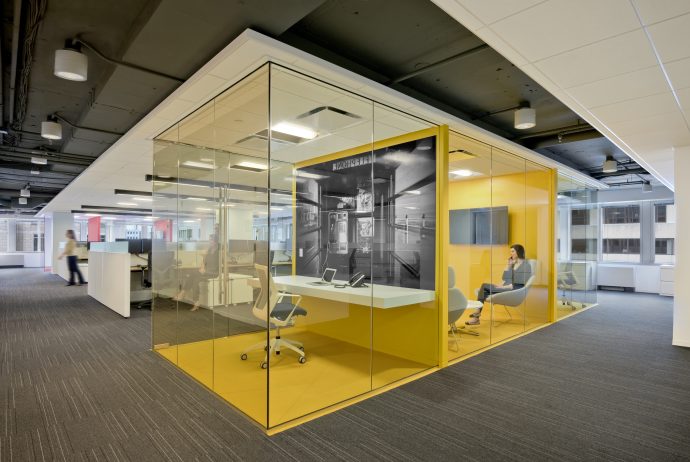
An individual may have an assigned workspace that is dedicated, but chances are it’s a smaller workstation, and it may be open. However, they have access to other spaces where they can get specific tasks done, and they may be common space and shared with everyone in the office.
Realities of the “Mine” Mindset
In many organizations today, the culture still embraces the “ownership” of space and therein lies the rub. “You are taking away my office.” The concept of “my office” is fading; dedicated/assigned office space is costly, it limits desirable interaction and is often empty. That kind of space is becoming a shared community function, as opposed to a dedicated personal right. The function provided by the private office is not going away, how it is utilized though, is very different. Use it when you need it, but when you are not using it, someone else will be using it.
The problem is not “open office.” The problem is due in large part to the lack of proper discussion, consideration, and planning of everything that the culture and the work entails – there is an appropriate solution – It’s probably not open. It’s not about merely putting butts in seats – it’s about all the details and nuances necessary to get work done and achieve the company goals. Paying attention to that will ensure the physical workspace is a success.
There are a lot of bad open office work environments that exist that were not given the necessary planning and thought required. Many started off to reduce the real estate costs which are a laudable goal, but often blind to the subtler functions necessary for a healthy and productive office.
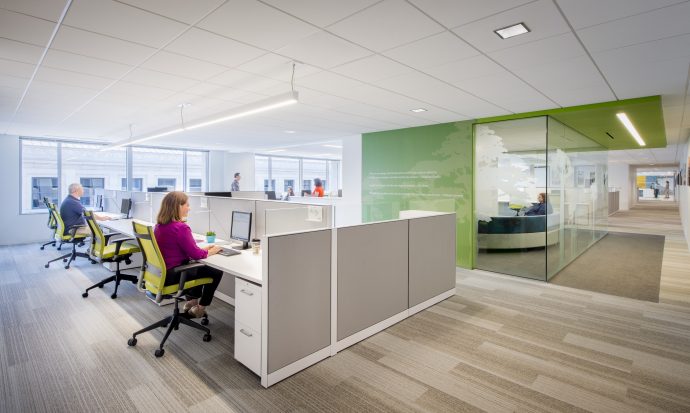
The conversation is quickly changing, it’s about people and taking into consideration how they approach their work and creating the space and work environment that incorporates the right tools needed to meet the unique needs of your organization.
When you look at all those shoes in your closet – think about the ones that you wear for each of your activities. Think of your space like those shoes, each pair serves a different activity, you perform better with the right pair; the space you use to get work done is not much different.



[…] Issue #3 – What works for one industry or company may not work for another. “It’s about all the details and nuances necessary to get work done and achieve the company goals. Paying attention to that will ensure the physical workspace is a success….” 1 […]
Does no one value privacy or personal space anymore? 20+ years ago employees worked in cubicles with high walls and enjoyed some degree of privacy. Today most of us work in “open” floor plans with short-walled cubes clustered together with absolutely no privacy. I find it very uncomfortable and have a hard time concentrating on my work. Employers talk about “collaboration” and “group synergy”, but we all know the purpose of the open floor plan is to save money by crowding more people into less space, with the added benefit to management of being able to easily keep an eye on their workers.
Yes, privacy is still needed in the workplace along with spots to do focused work. In some open-plan offices, they now have phone booths, which are great options for quiet spaces (ie like those on http://www.converstation.net).
[…] https://workdesign.com/2018/08/open-offices-debate/ […]
[…] https://workdesign.com/2018/08/open-offices-debate/ […]